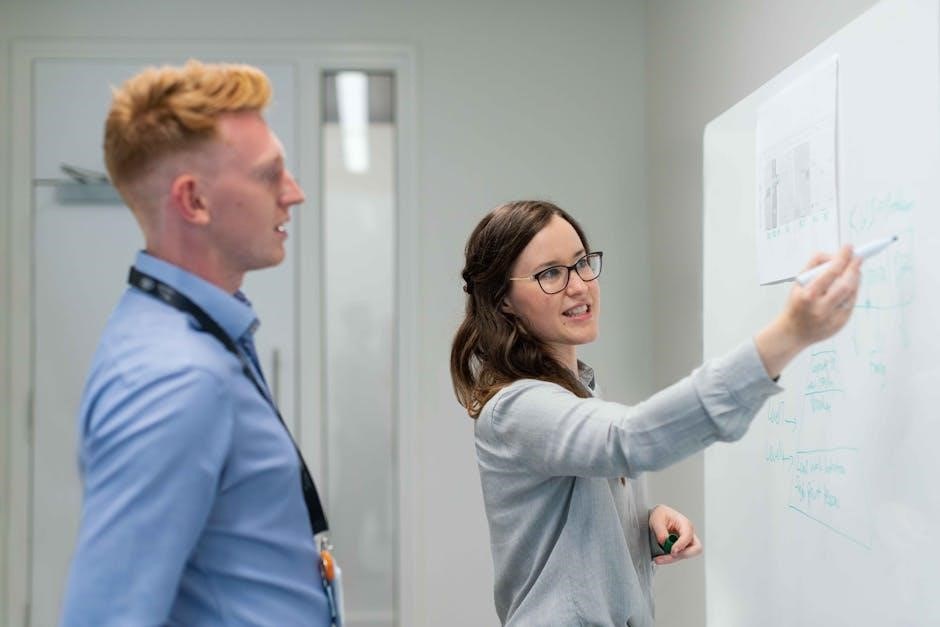
what is a curative instruction
Curative instructions are given to mitigate harm from improper evidence, with judges providing guidance to juries through
- specific directions
to ensure fair trials and correct verdicts are reached quickly.
Definition of Curative Instructions
A curative instruction is a direction given by a judge to a jury to correct an erroneous instruction or mitigate the risk of harm resulting from improper evidence or argument;
This type of instruction is designed to fix any mistakes made during the trial and ensure that the jury has the correct information to make their decision.
The purpose of a curative instruction is to neutralize any potential prejudice that may have resulted from the improper evidence or argument, and to provide the jury with a clear understanding of the law and the facts of the case.
According to various sources, a curative instruction can be given in different forms, including a directed verdict or an instructive verdict, and is typically given immediately after the damage is done.
The instruction is intended to guide the jury in their deliberations and ensure that they reach a fair and impartial verdict.
It is an important tool for judges to use in maintaining the integrity of the trial process and ensuring that justice is served.
The definition of curative instructions is closely tied to the concept of fairness and impartiality in the trial process.

Types of Curative Jury Instructions
Curative jury instructions include directed verdicts and instructive verdicts, guiding juries through
- specific directions
to reach fair verdicts quickly and correctly every time.
Directed Verdict Instruction
A directed verdict instruction is a type of curative instruction given by the judge when the evidence presented is overwhelming, leading to only one reasonable conclusion.
This instruction is typically given when the judge is convinced that the evidence clearly favors one party, and a verdict in their favor is the only reasonable outcome.
The instruction is designed to guide the jury towards a specific verdict, ensuring that the trial is concluded fairly and efficiently.
In such cases, the judge may instruct the jury to return a verdict in favor of one party, as the evidence presented does not support any other outcome.
The directed verdict instruction is an important tool in ensuring that the legal process is fair and just, and that the rights of all parties are protected.
The judge’s decision to give a directed verdict instruction is based on the evidence presented and the applicable law, and is intended to prevent unnecessary deliberation by the jury.
The instruction is usually clear and concise, leaving no doubt as to the desired outcome.
The directed verdict instruction is a crucial aspect of the legal process, and is used to ensure that justice is served in a fair and efficient manner.
The instruction is given to prevent further unnecessary proceedings, and to bring the trial to a close in a timely manner.
The judge’s decision to give a directed verdict instruction is final, and is not subject to appeal.
The instruction is a key component of the legal system, and is used to ensure that the rights of all parties are protected and that justice is served.
The directed verdict instruction is an important part of the curative instruction process, and is used to guide the jury towards a fair and just verdict.
The instruction is designed to prevent errors and ensure that the trial is concluded fairly and efficiently.
The judge’s decision to give a directed verdict instruction is based on the evidence presented, and is intended to prevent unnecessary deliberation by the jury.
The instruction is usually given in cases where the evidence is overwhelming, and a verdict in favor of one party is the only reasonable outcome.
The directed verdict instruction is a powerful tool in the legal process, and is used to ensure that justice is served in a fair and efficient manner.
The instruction is given to guide the jury towards a specific verdict, and to prevent errors in the trial process.
The judge’s decision to give a directed verdict instruction is final, and is not subject to appeal, and the instruction is a key component of the legal system.
Instructive Verdict Instruction
An instructive verdict instruction is a type of curative instruction given by the judge to the jury, providing guidance on the law and the evidence presented during the trial, and is typically used to clarify complex issues.
The judge wants to ensure the jury understands the relevant laws and facts, and this instruction helps to prevent misinterpretation of the evidence.
This type of instruction is often given when the judge believes the jury may be confused about certain aspects of the case, and it is intended to provide clear and concise guidance to help the jury reach a verdict.
The instructive verdict instruction is an important tool for judges to use in ensuring that the jury has a clear understanding of the law and the evidence, and it can help to prevent errors in the verdict.
The instruction is typically given after all the evidence has been presented, and it is intended to summarize the key points of the case and provide guidance on the relevant laws.

Purpose of Curative Instructions
The purpose is to mitigate harm and ensure fair trials through
- proper guidance
to juries quickly.
Neutralizing Harm
Neutralizing harm is a crucial aspect of curative instructions, as it aims to mitigate the damage caused by improper evidence or arguments presented during a trial. This can be achieved through specific directions given to the jury, such as ignoring certain statements or considering only specific evidence. According to various court rulings, a curative instruction can be effective in neutralizing harm if it is given immediately after the damaging statement or evidence is presented. The instruction should clearly state what the jury should disregard and why, and it should be given in a way that is clear and concise. By neutralizing harm, curative instructions can help ensure that the jury reaches a fair and impartial verdict, which is essential for upholding the integrity of the judicial system. The goal is to prevent any prejudice or bias from influencing the jury’s decision, and to ensure that justice is served.
Correcting Errors
Correcting errors is a key function of curative instructions, as they provide a means to rectify mistakes made during a trial. This can include correcting erroneous statements, clarifying ambiguous instructions, or providing additional guidance to the jury. Through curative instructions, judges can address errors that may have occurred during the trial, such as improper evidence or arguments, and ensure that the jury has a clear understanding of the law and the facts. By correcting errors, curative instructions can help prevent miscarriages of justice and ensure that the trial is fair and impartial. The use of curative instructions to correct errors is an important aspect of the judicial process, as it helps to maintain the integrity of the trial and uphold the principles of justice. This process is essential to ensuring that the legal system functions fairly and effectively.

Provisions and Rules
Rules like Uniform Rule 6 and California Evidence Code 355 govern curative instructions, guiding judges on their application and use in court proceedings to ensure fairness and justice.
Uniform Rule 6
Uniform Rule 6 is a provision that deals with the limitation of evidence and the use of curative instructions in court proceedings. This rule is designed to ensure that judges have the authority to limit or exclude evidence that may be prejudicial or irrelevant to the case. The rule also provides guidance on the use of curative instructions, which are given to the jury to mitigate the harm caused by improper evidence or arguments. According to the rule, curative instructions should be given in a timely manner and should be clear and concise in order to be effective. The rule also emphasizes the importance of ensuring that the jury is not unfairly influenced by improper evidence or arguments. By following Uniform Rule 6, judges can help to ensure that trials are fair and that justice is served. The rule is an important part of the legal system and is used in many jurisdictions.
California Evidence Code 355
California Evidence Code 355 is a law that governs the use of curative instructions in court proceedings. This code section provides that a judge may give a curative instruction to the jury in order to remedy any harm caused by the admission of improper evidence. The code section emphasizes the importance of ensuring that the jury is not unfairly influenced by such evidence. According to the code, a curative instruction should be given in a timely manner and should be clear and concise in order to be effective. The code also provides guidance on the content of curative instructions, including the requirement that they be tailored to the specific circumstances of the case. By following California Evidence Code 355, judges can help to ensure that trials are fair and that justice is served. The code is an important part of California’s evidence law and is used in many types of cases.

Case Law and Precedents
Courts establish precedents through rulings, shaping curative instruction guidelines, with judges using
- past decisions
to inform their rulings quickly and effectively.
Barragan v. United States
The case of Barragan v. United States sets a precedent for curative instructions, establishing that a curative instruction can neutralize harm caused by a prosecutor’s improper statements.
According to the ruling, the instruction must be given immediately after the damage is done and mention the specific statements made.
This ruling has been cited in numerous cases, shaping the guidelines for curative instructions and their application in court proceedings, with judges using this case as a reference point to inform their decisions and ensure fair trials, the ruling has had a significant impact on the use of curative instructions in similar cases, providing a framework for judges to follow when dealing with prosecutorial misconduct, and ensuring that the rights of defendants are protected, while also allowing for the correction of errors and the mitigation of harm, ultimately contributing to the fairness and integrity of the trial process.
Darby v. United States
The case of Darby v. United States is a significant one, providing insight into the use of curative instructions in court proceedings.
According to the ruling, a curative instruction is a direction given by a judge to a jury to correct an erroneous instruction, with the goal of fixing mistakes made during the trial.
This case has been cited as a reference point for understanding the purpose and application of curative instructions, shaping the guidelines for their use in court, and informing judges’ decisions on how to mitigate harm and ensure fair trials, the ruling in Darby v. United States has contributed to the development of curative instructions as a tool for correcting errors and promoting fairness in the trial process, with its impact still felt in modern court proceedings, as judges continue to rely on this case to guide their decisions on curative instructions, and ensure that the rights of all parties are protected.
Leave a Reply
You must be logged in to post a comment.